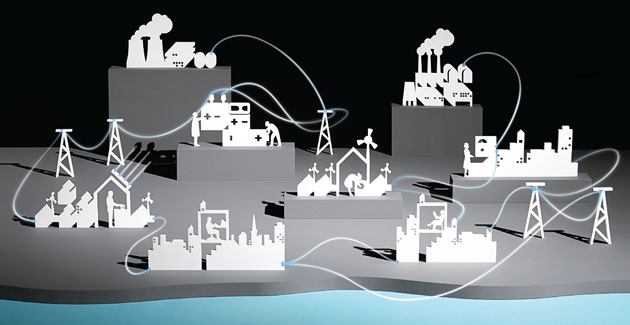 Power to the People: 7 Ways to Fix the Grid, NowMar 23, 2009 - Brendan I. Koerner - Wired Magazine
Filthy coal-fired power plants spew carbon into the air. A mish-mash of 9,200 generators streams vital electrons along 300,000 miles of aging, inefficient transmission lines and one untrimmed tree in the wrong place could plunge a quarter of the country into darkness. This is our electric grid. A whopping 40 percent of all the energy used in the US—be it oil, gas, wind, or solar—is converted into electrons that travel over these wires. Any attempt at energy reform must begin here. But this keystone of our 21st-century economy has yet to advance much beyond its 19th-century roots. Considering how wasteful, unresponsive, and just plain dumb the grid is, it isn't surprising that outages—which have been increasing steadily over the past quarter century—cost us $150 billion a year. The real shock is that the damn thing works at all. Now consider what we will ask the grid to handle in the near future: Demand for electricity is expected to increase by as much as 40 percent in the next two decades—more than twice the population growth rate. To meet that need, we will have to generate an additional 214 gigawatts, a feat that would require the construction of more than 357 large coal plants. We also want to plug in dozens, if not hundreds, of gigawatts of wind and solar power harvested from the most remote corners of the country. And we will want to recharge millions of electric vehicles every night, without fail. That is why we must fix the grid—reinvent it to be reliable, efficient, responsive, and smart. Washington is already on the case: President Obama has called a new energy agenda "absolutely critical to our economic future," and his stimulus package directs more than $40 billion toward that goal—the largest single infusion of government capital to the energy sector in US history, more than half of which will go to grid-related projects. In the short term, this bonanza aims simply to create jobs. But in the long term, it lays the groundwork for the grid of the future. (About $400 million will go to fund ARPA-E, a sort of Darpa for energy research.) And this is just the beginning: Congress is considering additional legislation in the hope of remaking our energy infrastructure. Private enterprise is on board as well. Just take a spin through General Electric's Smart Grid Lab in Niskayuna, New York, which will simulate an entire electric system—complete with the kind of state-of-the-art meters, software, and communication tech that will enable a smarter grid. Or check out Google's new PowerMeter, a Web app designed to give consumers instant information about their energy usage. But technology alone won't solve this mess, because fixing the grid is not a technology problem—it's a system problem on the broadest scale. Political gridlock, broken markets, and shortsighted planning have created a slew of bottlenecks that can't be solved with a bunch of smart meters and fancy routers. Here, we show how utilities and businesses have begun to tackle those obstacles—from installing new transmission lines to empowering consumers. If we're serious about remaking our energy infrastructure, we'll need to encourage these kinds of fixes and replace our current system of misplaced incentives. Right now, that system encourages everyone involved—customers, utilities, and private industry—to neglect the grid. We have to give those stakeholders new reasons to turn on, engage, and transform. Go ahead, blame Edison. He's the guy who invented the business model that got us into this mess. Edison Electric Light, founded in 1880, was a vertically integrated monopoly that controlled everything from generation to distribution. (It even owned the bulbs in customers' homes.) As utilities sprouted across the country, they saw no reason to deviate from Edison's successful blueprint. For its first century, then, the electricity industry was a simple affair. Most states anointed a single utility to provide all the power to its citizens. These utilities owned the plants that generated the electricity, the transmission lines that carried it to substations, and the wires that distributed it to customers. When more power was needed, they simply built another coal-fired plant and spliced it onto the grid. Rates had to be approved by a public-service commission, but otherwise the utilities were autonomous. (They linked their systems to neighboring grids, but mostly for backup.) Electricity was inexpensive and abundant, and the system's reliability was the envy of the world. What it wasn't? Efficient. Since the utilities had a captive market and seemingly unlimited access to cheap fossil fuels, they had no incentive to upgrade their leaky old plants. No one complained as long as energy was seen as plentiful and harmless. Then came the fuel crisis of the 1970s, along with the rise of environmentalism. In 1978, Congress began chipping away at the utilities' dominance by forcing them to buy electricity from independent generation companies that met efficiency goals. Fourteen years later, the government went much further, ordering the utilities to open their transmission lines to all comers. The result was utter chaos. Many utilities got out of the generation business and morphed into middlemen, shopping for the cheapest power—often from areas with low labor costs and lax environmental oversight—and transporting it hundreds, even thousands, of miles to their customers. This meant using the links between grids, which hadn't been designed to accommodate such heavy traffic. The grids of distant states thus became closely intertwined, so that an outage in one rural county could affect millions of far-flung customers. |
Email this page to a friend
If you speak another language fluently and you liked this page, make
a contribution by translating
it! For additional translations check out FreeTranslation.com
(Voor vertaling van Engels tot Nederlands)
(For oversettelse fra Engelsk til Norsk)
(Для дополнительных
переводов проверяют
FreeTranslation.com )








